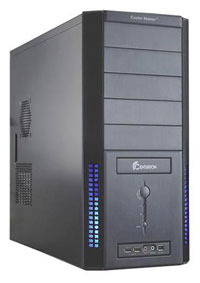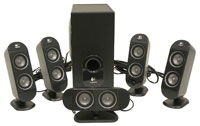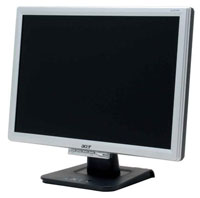Basic Configuration - Accessories
All of the components we've discussed so far tend to have more of an impact on overall system performance. What remains are the miscellaneous accessories that may not impact performance at all, but they do influence other areas of the computing environment. Personal preference will play a larger role in many of these components, so as always we would recommend people stick with what they like first and only branch out if you are looking to try something else. Most of the base selections can be used with any of the builds we will be putting together without any difficulty, and we will try to make note of any exceptions.
For optical storage, Blu-Ray and HD-DVD are still too expensive to warrant inclusion in a midrange computer, so we return to the venerable DVD+RW. Most companies now offer 18X burn speeds, which are barely faster than the old 16X maximum, and street prices bottom out at around $30. The LG GSAH22N includes all the standard features as well as 12X DVD-RAM support and works well with a variety of media, so it gets our recommendation. We're still waiting for reasonably priced SATA optical drives that can deliver similar overall quality, unfortunately.
 |
The computer case is one of the items that you will see a lot, but you really only have to work with it once or twice during the life of the typical computer (unless you upgrade frequently). Appearance is definitely an important consideration for many people, and what one person finds attractive another will find ugly or boring. Besides the appearance, the choice of case will also impact noise levels, cooling, and ease of installation. The cheapest cases tend to be made of thin steel, which gives them sharp edges internally and also makes them pretty flimsy. They will still suffice for most people, but we prefer slightly more expensive cases. Cooler Master has a large selection of reasonable midrange cases, and most of us find them to be easy to work with and reasonably attractive. Antec, In Win, Thermaltake, Apevia, Lian Li, and others offer alternatives worth considering, and if you are more budget minded the Rosewill brand is worth a look. We like cases that support 120mm fans (at least one) as they will typically offer better cooling with lower noise levels. Beyond that, remember to make sure your optical drive matches whatever case you choose.
 |
Of far more concern than the case is going to be the power supply you use, particularly in some of the upgraded midrange configurations. Getting a case with an included power supply will usually save you some money, and most power supplies rated at 350W or higher are sufficient for a midrange computer. Still, when you consider that you're spending over $1000 on all of the other components, we really hesitate to shave $40 or $50 off the total price by sticking with a low-end power supply. We've selected a reasonably priced 450W Fortron Source PSU as our basic recommendation, and that should be more than enough for any midrange computer, other than for serious overclocking. Fortron Source is a well-regarded PSU manufacturer, and they are often used as the basis of OEM power supplies. The only potential drawback of the AX450-PN is that it only has a 70% efficiency rating, but if you want a higher efficiency power supply you will have to spend more money. We're more concerned about power supply noise levels than efficiency, and while the two are related the 120mm fan used in the FSP helps to keep noise levels down. If you're willing to spend a bit more money and you want the best of both worlds - quiet and efficient - SeaSonic gets a strong recommendation. They tend to cost more for lower wattage ratings, but a SeaSonic S12-330 performs better than most other 400-450W power supplies. OCZ, Enermax, and several other companies also make some very good high-end power supplies, which we will discuss a bit further in the overclocking configuration, but SeaSonic remains one of the quietest (short of purchasing a fanless PSU).
 |
Keyboard, mouse, and speakers are three items where you can either go for the bare minimum cost and functionality, or you can spend a lot of money for extra features. We have selected what we feel are good options for all three areas, and it would be hard to find anything that's truly "better" without spending more money. Our performance configuration will include better speakers, but we didn't feel the need to upgrade the keyboard or mouse on any of the builds. If you want to get a wireless keyboard and mouse, our advice is to spend more money rather than less. The $30-$40 packages generally don't perform as well as we would like, so unless you absolutely want wireless input devices, we prefer to spend the extra money elsewhere.
 |
The last accessory is the display, and as we have said on many occasions we would much rather have a very nice display with a decent computer than to have an excellent computer with a lousy display. LCD prices have continued to drop, although even the cheapest 19" models still tend to cost just under $200. The 19" LCDs are still a good option, but for the extra money we would prefer to get a 20" LCD that comes with a higher resolution. Most of us also prefer widescreen LCDs these days, and although there are a few gaming titles that continue to cause irritation by not natively supporting widescreen resolutions, moving forward WS support should become commonplace. Outside of games, watching widescreen movies is definitely preferred, and we enjoy the extra screen width on the Windows desktop as well. Looking at the various 20" widescreen displays that are available, Acer once again has one of the best price/performance offerings. ViewSonic, BenQ, Samsung, and several other companies make similar LCDs, but they all cost a bit more and it is difficult to say that they actually look much better than the Acer model. For $230, most people will be very happy with the Acer AL2016W.
For the operating system, we selected Windows XP Media Center Edition 2005. It only costs slightly more than XP Home, and it allows you to upgrade to Vista Home Premium as we mentioned earlier. The DVR functionality may not be necessary, but it doesn't hurt either, and the only features that XP Pro adds (i.e. hard drive encryption) are not used by most people.














43 Comments
View All Comments
dm - Friday, January 19, 2007 - link
Hey, I like this article. Very nicely written and "right on time"!!! Btw, if I may request, could you guys make a write up about "specialized" items? I mean, like this pico PSU and Mini-ITX combo:http://fanboyreview.blogspot.com/2006/01/tech-link...">http://fanboyreview.blogspot.com/2006/0...link-pow...
http://fanboyreview.blogspot.com/2006/02/press-rel...">http://fanboyreview.blogspot.com/2006/0...ss-relea...
I'd love to see you guys build one, bring it to the test bench, and tell use where to get those parts. I just can't find them :(
Le Québécois - Friday, January 19, 2007 - link
I think this is the first Buyer's guide from Anandtech.com that I read that doesn't completely include both Intel and AMD. Yes it still mention what AMD could be use if you don't go with the listed Intel configuration but it doesn't tell you the price or what motherboard you should buy if you would choose to go with AMD. I know AMD is not the best way to go right now but still I find this a little confusing when I go back in the "Mid-Range Buyer's Guide, September 2005" and find this :But still that guide provided us with both Intel and AMD options.
Yes AMD is on the first page with Intel but it's the only page for this guide. What's happening to Anandtech integrity? Or it's just the way every guides will appear from now on even if AMD manage to get back at Intel?
If it's the case, I don't think it's a good idea because some peoples are fanboys and will never go with AMD or Intel and leaving out either Intel or AMD from a guide may leave these persons in the dark since many of them don't take times to read every articles that are published on Anandtech.
JarredWalton - Saturday, January 20, 2007 - link
Honestly, I got tired of putting together system configurations that I really wouldn't recommend. The AMD configuration listed is very good for a midrange PC, so I included it. As a gaming platform, AMD is still fine, but if you want a high-end gaming system would you really want to pair it with a lesser CPU? Overclocking there's really not much point in getting a new AMD right now, I don't think - some of the lower end parts and the Opteron models can overclock pretty well, but when Core 2 leads in clock-for-clock comparisons and you can usually get an extra 500+ MHz out of it, it's just not even close.Really, I thought it would be more interesting to take a look at several different options for a midrange computer rather than doing the same old thing again. The way I see it, most of the changes made are minor upgrades to the CPU/mobo, so only the other parts are really changing. You could use the base AMD system and make the same upgrades, only keep the mobo constant, and you'd pretty much be fine. I still have several dozen PCs that have AMD processors and only one Core 2 of my own, for what it's worth. (No need to upgrade any of the systems right now, as they're fast enough.)
yyrkoon - Sunday, January 21, 2007 - link
This is from a motherboard that you guys recently did a spot light on in one of your CES articles. 900MHZ - 1.1 GHZ is a bad overclock ?
http://www.newegg.com/Product/CustratingReview.asp...">http://www.newegg.com/Product/CustratingReview.asp...
Post #5, and I suppose someone could possibly fabricated their review, but this one person isn't the only person on newegg claiming this motherboard is a very good overclocker, perhaps you guys should convince AMD + ABIT sending you parts for review ?
Now, on the reverse side, I'm still not quite sure it is worth investing in an AMD CPU for overclocking, Intels current CPUs seem a bit cheaper overall, but hey, the opterons might not be fully supported on this motherboard, but they seem to be working, and quite well, according to several reviewers.
JarredWalton - Sunday, January 21, 2007 - link
You can get Opterons to hit ~3.0GHz with pretty much full stability, but when those cost as much as an E6400 that will hit 3.5+ GHz with full stability, it's pretty clear why we think Core 2 is the better overclocking choice. A 50% or higher overclock is nothing to scoff at, but E6300 is basically only limited by motherboard and RAM in many cases, and E4300 ought to hit 100% overclocks routinely. (Yikes!)yyrkoon - Sunday, January 21, 2007 - link
Yeah, I never said it was a viable comparison, but for die hard AMD fans, its definately an option. I mean, what I would really like to see, is some real world hard data, on an Opteron vs maybe each of the conroe CPUs. I've little doubt, all CPUs overclocked, that every Conroe would outperform anything AMD, however, how much of a real world difference would it really make ?Some of us have already invested into AM2 systems, and could upgrade a good bit cheaper to an Opteron, vs. a C2D CPU, so the real question is, is it really worth the cost of the motherboard, to go that route, instead of just buying an Opteron? We've all seen your game numbers for FPS etc., but would those numbers really translate into a hugely noticeable difference ?
I for one, if gone C2D, would buy a top of the line i680 board (most likely ABIT), and probably an E6600, if gone AMD, an Opteron 1214-1216 (I like the even numbered, higher multiplier on the 1216), and the ABIT motherboard mentioned above. Also, since my business partner here just purchased the that ABIT AM2 board, I have the luxury of seeing it in action, before I purchase for myself.
Also, since i payed only $54 for my current system board, and not very much for the single core 3800+ im currently using, its not as though I'm out a whole lot, no matter what I do. One thing is for sure however, this motherboard WILL get replaced, I'm not too fond of it, and its not very stable compared to anything I've owned from ABIT.
JarredWalton - Monday, January 22, 2007 - link
How much of a difference it would make depends largely on what sort of application you're running, as well as the other hardware in the system. If you don't have a top end graphics configuration and you're worried about gaming performance, in most cases the difference between the various current processors is going to be very small. If you're running a couple of 8800 GTX cards, the difference could be quite a bit larger depending on resolution. I figure anyone that has the money to buy a couple of 8800 GTX GPUs should probably already have at least an E6600 processor, because if you're willing to spend that much money on graphics cards $300 on a processor doesn't seem like a whole lot.Other applications (3D rendering, video encoding, office tasks) will show more or less of a difference. Core 2 Duo should be faster in most of those, especially with overclocking, but if you never happen to run any of those tasks it really doesn't matter much. If you already have a decent AM2 setup and can hold out, I would be far more interested in waiting to see what the K8L processors can manage to do -- granted that appears to be about six months out, but I doubt anything significant is going to happen in the software market before then that would necessitate a CPU upgrade. (Maybe Vista might do it?)
yyrkoon - Monday, January 22, 2007 - link
Yeah, well I for one, am not too enthusiastic about the socket F platforms (assuming this is what you mean about K8L). I used to follow the road maps of each side, to the point that I would be easily disappointed when the chips actually arrived. Now, I just wait, and see what happens when it happens, at least, for CPUs. Personally, the technology I've been following for a while, thats not due out until perhaps quarter 3 is PCI-E v2.0, and the PCI-E to PCI-E peer to peer communications (potential of 160Gbit/s throughput . . .). Something tells me though, that either 1) this technology will be further out than quarter 3, 2) is all smoke an mirrors, 3) will cost WAAAAY more than 10GbE currently costs now.Anyhow, my point basically is, you can wish in one hand, and .... in the other, and see which one fills up faster. In other words, it wont happen, until it happens :)
JarredWalton - Tuesday, January 23, 2007 - link
I'm pretty sure AMD is going to release some sort of updated CPU (quad core maybe - not sure on that) for AM2 round about summer time. My understanding (which admittedly could be wrong) is that K8L will be available for socket F as well as AM2, just like the current K8 line. Socket F just supports multiple CPU sockets whereas AM2 is for single chips. That's why we have Opteron 12xx parts for AM2 and 22xx/82xx for socket F.As for PCI-E stuff, most of the new items won't really matter on the desktop. It's like having a PC with 80GB/s of memory bandwidth; if the CPU only needs 5-8GB/s everything else is just wasted.
Le Québécois - Saturday, January 20, 2007 - link
OK, thanks for taking some of your time to explain why you did this. I don't have any things personal against this approach since I do read every one of Anandtech articles and have no problem building a computer on my own.I understand you got tired of writing about 2 differents builds of computer (AMD and Intel) for every guide even if one of those isn't a good choice (computing power or cost). I just found it odd to see it at this time when AMD is no so bad (I would buy a Core 2 Duo if I was looking for a computer right now but I'm still not ready to change my old one) and not a some times ago when Intel was like AMD is today, if not worst, like in the Buyer's Guide where I took my quote from.
Now if I think about it, maybe it's a good thing since it will force the fanboys to do some real research before blindly buying AMD or Intel just because of the name.
One last thing, when you say :
Are you saying that you personally own those PCs?
If so can I ask what are you doing with such an amount of PCs?